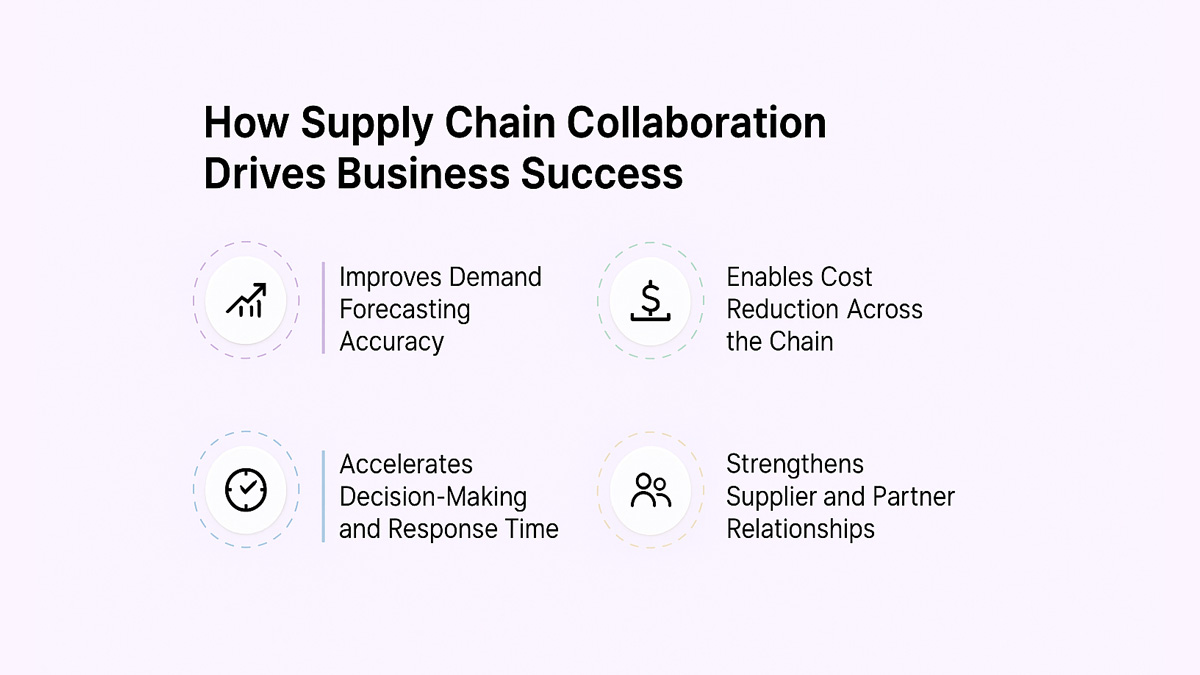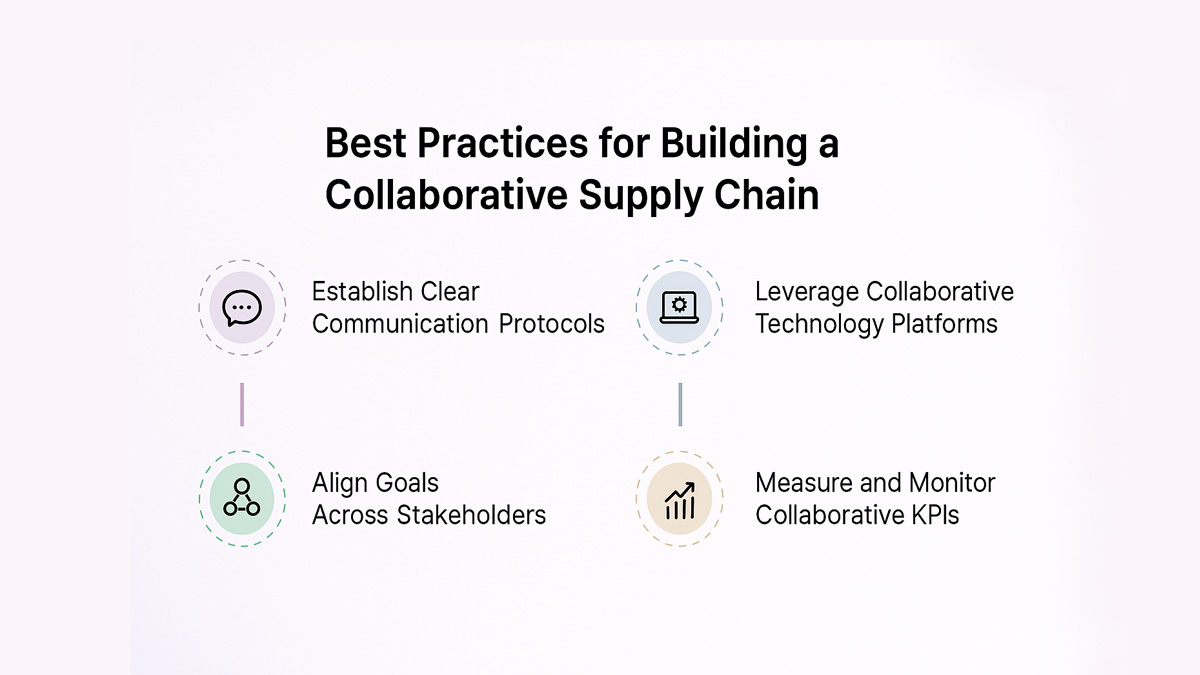

Unlocking the Benefits of Supply Chain Collaboration: Why It Matters More Than Ever

Unlocking the Benefits of Supply Chain Collaboration: Why It Matters More Than Ever
Learn how supply chain collaboration drives cost savings, better decisions, and stronger vendor partnerships.


Picture this - your top supplier delays a critical shipment. You’re not the first to know. And by the time the information reaches your team, it’s already caused a domino effect across production, delivery, and customer service. Now imagine a world where your partners, vendors, and departments all move in sync - anticipating issues before they snowball. That’s the power of supply chain collaboration. A truly collaborative approach ensures every stakeholder contributes to shared goals instead of working in isolation.
What this blog covers:
- What is supply chain collaboration?
- Why is supply chain collaboration important?
- Key benefits of supply chain collaboration
- Best practices to enable effective supply chain collaboration
- How Spendflo helps with supply chain collaboration
- Frequently asked questions on supply chain collaboration
What is Supply Chain Collaboration?
Supply chain collaboration is the strategic alignment of multiple stakeholders - manufacturers, suppliers, logistics providers, distributors, and even customers - working together to optimize the flow of goods, information, and finances. This coordination improves transparency, speeds up decision-making, and allows everyone in the chain to operate more efficiently while reducing costs and risks. The outcome is an efficient supply chain that can adapt quickly to new opportunities and challenges.
Why Is Supply Chain Collaboration Important
A collaborative supply chain isn’t just a nice-to-have - it’s a competitive advantage. As markets grow more interconnected and unpredictable, isolated operations simply can’t keep up. Businesses that collaborate across the chain gain faster access to information, reduce waste, and improve service delivery. The result is an agile supply chain capable of adapting to both sudden spikes and drops in demand.
Here are the reasons why supply chain collaboration is important:

Improves Demand Forecasting Accuracy
When suppliers and retailers share sales data, market trends, and inventory levels, forecasting becomes a team sport - and a more accurate one at that. This teamwork ensures production stays closely aligned with real market demands. With everyone working off the same data, businesses can better predict demand, avoid stockouts, and reduce excess inventory. Modern predictive analytics tools take this further by identifying demand shifts before they occur. It smooths out the peaks and valleys of supply and demand cycles.
Enables Cost Reduction Across the Chain
Collaboration opens the door to shared logistics, consolidated shipments, and reduced overhead. This also helps streamline production processes by syncing material availability with manufacturing schedules. For example, joint purchasing agreements can lead to bulk discounts, while coordinated production schedules can cut down holding and handling costs. Businesses can also reduce transportation costs by optimizing shared delivery routes and logistics planning. These savings ripple across the entire supply chain - not just for one player. Over time, this collective efficiency translates into measurable cost savings that benefit all partners involved.
Accelerates Decision-Making and Response Time
In a connected chain, decisions aren’t made in silos. Real-time communication and shared visibility enable faster reactions to disruptions, from raw material shortages to sudden shifts in customer preferences. This preparedness helps minimize the impact of supply chain disruptions before they affect operations. Instead of weeks of back-and-forth emails, stakeholders can act immediately with confidence.
Strengthens Supplier and Partner Relationships
Trust grows when everyone is aligned on goals, metrics, and expectations. Shared visibility and commitment to common goals foster collaboration that lasts. Collaborative relationships are less transactional and more strategic. Long-term partners are more willing to go the extra mile during crunch times, renegotiate terms during downturns, or innovate together for mutual growth.
Key Benefits of Supply Chain Collaboration
When supply chain partners work together instead of operating in silos, the results go beyond efficiency. The outcome is improved efficiency that drives faster cycles and better use of resources. Collaboration unlocks a range of strategic benefits that directly impact cost, service, and growth.
Here are some of the most valuable outcomes:
Enhanced Visibility Across Operations
Collaboration allows companies to share data seamlessly - from inventory levels to shipment statuses. This transparency eliminates blind spots and enables proactive problem-solving. Teams can spot delays before they become crises and pivot quickly to keep operations on track. A proactive approach like this transforms how companies anticipate and handle potential risks.
Faster Problem Resolution and Reduced Delays
When a disruption occurs, collaborative partners can respond in real time. There’s no waiting for information to trickle down. Suppliers, logistics teams, and buyers can troubleshoot together, minimizing downtime and maintaining service levels. This flexibility helps businesses quickly adapt to market changes without disrupting delivery timelines.
Greater Customer Satisfaction and Loyalty
Customers care less about whose fault a delay is - they care about getting their product on time. Meeting or exceeding customer expectations consistently builds long-term brand loyalty. When supply chains function smoothly, customers get what they want, when they want it. Consistent performance leads to stronger loyalty, repeat business, and better reviews.
Reduced Inventory and Warehousing Costs
With better forecasting and information sharing, companies don’t need to stockpile as much safety inventory. That translates to lower holding costs, reduced spoilage for perishables, and more efficient use of warehouse space. This level of coordination also improves overall inventory management, keeping stock levels balanced and predictable.
Best Practices To Enable Effective Supply Chain Collaboration
Successful supply chain collaboration doesn’t happen by accident. It requires the right mix of processes, tools, and mindset shifts. When executed well, these practices create a culture of partnership rather than competition - one where every stakeholder contributes to shared success. This mindset is particularly critical in today’s complex supply chains, where collaboration determines resilience.
Here are some proven best practices:

Establish Clear Communication Protocols
Collaboration thrives on clarity. Define how and when information should be shared, what platforms should be used, and who is responsible for updates. Miscommunication is one of the biggest roadblocks in supply chains, so standardized channels and agreed-upon expectations keep everyone aligned.
Leverage Collaborative Technology Platforms
Cloud-based tools, shared dashboards, and integrated supply chain systems allow stakeholders to view real-time data across locations. Real-time data sharing ensures decisions are based on the most current and accurate information possible. These platforms break down silos and create a “single source of truth,” enabling faster decisions and more informed trade-offs. Tools like ERP integrations, supplier portals, and workflow automation go a long way here.
Align Goals Across Stakeholders
If one partner is focused on speed while another is optimizing for cost, collaboration will quickly hit a wall. Aligning goals - such as reducing lead times, improving quality, or minimizing returns - ensures that everyone is pulling in the same direction. Maintaining consistent product quality across suppliers is often one of the strongest outcomes of such alignment. Quarterly check-ins and shared KPIs can reinforce this alignment over time.
Measure and Monitor Collaborative KPIs
What gets measured gets managed. Set and track joint metrics that reflect the health of the collaboration. Examples include on-time delivery rate, forecast accuracy, fill rate, or cost-to-serve. These KPIs not only hold everyone accountable but also highlight areas for continuous improvement.
How Spendflo Helps with Supply Chain Collaboration
At Spendflo, we believe that collaboration starts with visibility - and visibility starts with control over your software stack. Many supply chain inefficiencies stem from disconnected tools, shadow IT, or fragmented procurement processes. Spendflo gives you a single, centralized platform to manage all SaaS subscriptions tied to your supply chain - from logistics tracking to procurement platforms and inventory systems.
Our procurement specialists work hand-in-hand with your teams to streamline vendor negotiations, unify procurement workflows, and eliminate redundant tools across departments. By ensuring every system in your supply chain tech stack is intentional, integrated, and cost-efficient, we help you foster better collaboration with both internal teams and external partners. This connected ecosystem sets the stage for long-term success built on trust and transparency.
Whether you’re scaling operations or navigating volatile supplier networks, Spendflo provides the foundation for smoother, smarter supply chain coordination - powered by clean data, transparent spend, and aligned stakeholders.
Frequently Asked Questions on supply chain collaboration
What are the benefits of supply chain collaboration?
Collaboration in the supply chain improves visibility, reduces costs, enhances demand planning, accelerates response to disruptions, and builds stronger relationships with suppliers and partners.
How does collaboration reduce supply chain costs?
By coordinating efforts, businesses can consolidate shipments, share logistics resources, and avoid duplication. Joint forecasting also reduces excess inventory and minimizes last-minute costly fixes.
What tools support better collaboration in the supply chain?
Cloud-based ERP systems, supplier portals, integrated inventory tools, and communication platforms like Slack or Microsoft Teams are commonly used to enhance real-time collaboration and data sharing.
Can small businesses benefit from supply chain collaboration?
Absolutely. Small businesses can gain access to better pricing, improved forecasting, and expanded reach by partnering with other players in the chain - often leveling the playing field with larger competitors.










.png)




.png)










.avif)





